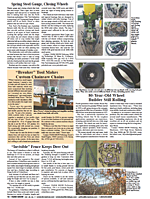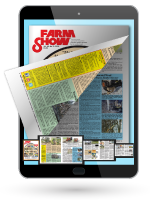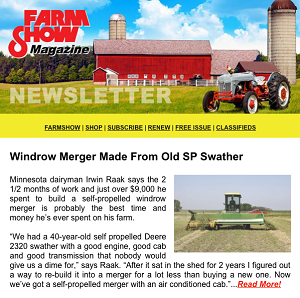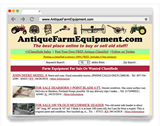Canadian Horse Breed Making A Comeback
After dropping to an estimated 400 registered animals in the 1970’s, the Canadian Horse breed numbers around 6,000 head today. The breed was first sent to Quebec by King Louis XIV in 1665. Over time the Canadian or Canadien (in Quebec) became known as “Le Petit Cheval de Fer” or “The Little Iron Horse.” It survived early harsh winters with little feed and lots of hard work to spread across the country and across the border with the U.S.
“Thanks to genetic testing, we know that the Canadian was a foundation breed in developing almost all North American breeds such as Morgans, Tennessee Walkers, Saddlebred, Missouri Fox Trotter and Standardbreds,” says Tina Morrison, Ontario director for the Canadian Horse Breeders Association. “Its versatility and heritage are remarkable. Many people think of Canadians as driving horses, but they excel in dressage, eventing, jumping and are great backyard horses. They can do whatever you want them to and are very sociable and intelligent.”
In addition to the breed’s role in establishing other North American breeds, the Canadians have been a warhorse. Thousands were exported to the U.S. during the Civil War. Canadians were also exported to Africa for use in the Boer War, and more than 150,000 were shipped to Europe during World War I.
“The Canadian Horse breed may be our country’s best kept secret,” says Morrison. “In 2002, it became the National Horse of Canada, which achieved a lot of recognition. However, it is the work of really dedicated breeders who have made a real effort to increase breed numbers.”
The versatility of the breed also shows up in its genetics. Horses vary in type and size, ranging from large, big boned horses to smaller, Morgan-like animals.
Although there are only 6 recognized bloodlines, breed size varies from 14 to 16 hands and 1,000 to 1,400 lbs. Most frequently black, they may also be brown, bay or chestnut.
Morrison reports that registered, trained Canadians average around $5,000. More highly trained horses will run higher. Stud fees run around $800.
The Canadian Horse Breeders Association is looking for people interested in expanding the breed, says Morrison. She notes a new website has been set up to identify breeder locations with available stallions.
Contact: FARM SHOW Followup, Canadian Horse Breeder’s Association/
Société des Éleveurs de Chevaux Canadiens, 59 rue Monfette Suite 108, Victoriaville, Que. Canada G6P 1J8 (info@lechevalcanadien.ca; www.lechevalcanadien.ca).

Click here to download page story appeared in.
Click here to read entire issue
Canadian Horse Breed Making A Comeback LIVESTOCK Horses/Mules After dropping to an estimated 400 registered animals in the 1970’s the Canadian Horse breed numbers around 6 000 head today The breed was first sent to Quebec by King Louis XIV in 1665 Over time the Canadian or Canadien in Quebec became known as “Le Petit Cheval de Fer” or “The Little Iron Horse ” It survived early harsh winters with little feed and lots of hard work to spread across the country and across the border with the U S “Thanks to genetic testing we know that the Canadian was a foundation breed in developing almost all North American breeds such as Morgans Tennessee Walkers Saddlebred Missouri Fox Trotter and Standardbreds ” says Tina Morrison Ontario director for the Canadian Horse Breeders Association “Its versatility and heritage are remarkable Many people think of Canadians as driving horses but they excel in dressage eventing jumping and are great backyard horses They can do whatever you want them to and are very sociable and intelligent ” In addition to the breed’s role in establishing other North American breeds the Canadians have been a warhorse Thousands were exported to the U S during the Civil War Canadians were also exported to Africa for use in the Boer War and more than 150 000 were shipped to Europe during World War I “The Canadian Horse breed may be our country’s best kept secret ” says Morrison “In 2002 it became the National Horse of Canada which achieved a lot of recognition However it is the work of really dedicated breeders who have made a real effort to increase breed numbers ” The versatility of the breed also shows up in its genetics Horses vary in type and size ranging from large big boned horses to smaller Morgan-like animals Although there are only 6 recognized bloodlines breed size varies from 14 to 16 hands and 1 000 to 1 400 lbs Most frequently black they may also be brown bay or chestnut Morrison reports that registered trained Canadians average around $5 000 More highly trained horses will run higher Stud fees run around $800 The Canadian Horse Breeders Association is looking for people interested in expanding the breed says Morrison She notes a new website has been set up to identify breeder locations with available stallions Contact: FARM SHOW Followup Canadian Horse Breeder’s Association/ Société des Éleveurs de Chevaux Canadiens 59 rue Monfette Suite 108 Victoriaville Que Canada G6P 1J8 info@lechevalcanadien ca; www lechevalcanadien ca
To read the rest of this story, download this issue below or click
here to register with your account number.








